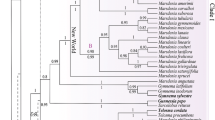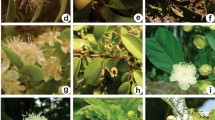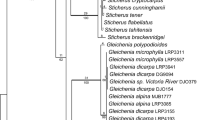Abstract
The genus Cecropia contains 61 species of high ecological importance in the Neotropics. Cecropia pachystachya Trécul has a wide geographic distribution and high morphological variability. The last taxonomic review of C. pachystachya was performed in 2005 and incorporated seven other Cecropia species by synonymization. However, this synonymization was not fully accepted by experts in Urticaceae because of high morphological variations in the taxon. In this study, we aimed to evaluate whether the morphological variations observed in C. pachystachya morphotypes also occurred at the DNA level and to contribute to the understanding of the evolutionary relationship between species morphotypes. Morphological analysis of eight species descriptors in 28 accessions of C. pachystachya allowed the differentiation of all five morphotypes evaluated. The analysis of the trnL-trnF (plastid) and ITS (nuclear) regions from 24 accessions by maximum parsimony, maximum likelihood, and Bayesian inference methods showed a robust molecular differentiation between C. pachystachya morphotypes. Climate was the main factor that seemed to influence clade formation in the phylogenetic trees. The higher genetic relation among morphotypes from the Amazon, Caatinga, and Cerrado regions corroborated previous hypotheses of close relationships between these biomes in past ages. The morphotype group from the Atlantic Forest seemed to be related to the proposed Pleistocene refuges to this biome. The overall analysis of morphological and molecular data shows robust differences between C. pachystachya synonymized morphotypes, which indicates the need of a taxonomic revision of the C. pachystachya complex and subsequent reinstatement of at least four synonymized species.


Similar content being viewed by others
References
Akaike H (1974) A new look at the statistical model identification. IEEE T Automat Contr 19:215–222
Altschul SF, Madden TL, Schäffer AA, Zhang J, Zhang Z, Miller W, Lipman DJ (1997) Gapped BLAST and PSI-BLAST: a new generation of protein database search programs. Nucleic Acids Res 25:3389–3402
Alvares CA, Stape JL, Sentelhas PC, Gonçalves JLM, Sparovek G (2013) Köppen’s climate classification map for Brazil. Meteorol Z 22:711–728
Batalha-Filho H, Fjeldsa J, Fabre PH, Miyaki CY (2013) Connections between the Atlantic and the Amazonian forest avifaunas represent distinct historical events. J Ornithol 154:41–50
Behling H (2001) Late Quaternary environmental changes in the Lagoa da Curuça region (eastern Amazonia, Brazil) and evidence of Podocarpus in the Amazon lowland. Veg Hist Archaeobotany 10:175–183
Behling H, Keim G, Irion G, Junk W, De Mello J (2001) Holocene environmental changes in the Central Amazon Basin inferred from Lago Calado (Brazil). Palaeogeogr Palaeoclimatol Palaeoecol 173:87–101
Benson WW (1985) Amazon ant-plants. In: Prance GT, Lovejoy TE (eds) Amazonia, 1st edn. Pergamon Press, Oxford, pp 239–266
Berg CC (1978) Cecropiaceae a new family of the Urticales. Taxon 27:39–44
Berg CC, Rosselli PF (2005) Cecropia. Flora Neotropica 94:1–230
Bigarella JJ, Andrade-Lima D, Riehs PJ (1975) Consideracões a respeito das mudanças paleoambientais na distribuição de algumas espécies vegetais e animais no Brasil. An Acad Bras Ciênc 47:411–464
Carauta JPP (1996) Grupo “Cecropia pachystachya”. In: Berg, CC. Cecropia (Cecropiaceae) no Brasil, ao sul da Bacia Amazônica. Albertoa 4:213–221
Carnaval AC, Moritz C (2008) Historical climate modelling predicts patterns of current biodiversity in the Brazilian Atlantic forest. J Biogeogr 35:1187–1201
Carnaval AC, Hickerson MJ, Haddad CF, Rodrigues MT, Moritz C (2009) Stability predicts genetic diversity in the Brazilian Atlantic forest hotspot. Science 323:785–789
Carnaval AC, Waltari E, Rodrigues MT, Rosauer D, VanDerWal J, Damasceno R, Prates I, Strangas M, Spanos Z, Rivera D, Pie MR, Firkowski CR, Bornschein MR, Ribeiro LF, Moritz C (2014) Prediction of phylogeographic endemism in an environmentally complex biome. P Roy Soc B-Biol Sci 281:1–8
Cavers S, Telford A, Arenal Cruz F, Pérez Castañeda A, Valencia R, Navarro C, Buonamici A, Lowe A, Vendramin G (2013) Cryptic species and phylogeographical structure in the tree Cedrela odorata L. throughout the Neotropics. J Biogeogr 40:732–746
Cazé ALR, Mäder G, Nunes TS, Queiroz LP, de Oliveira G, Diniz-Filho JAF, Bonatto SL, Freitas LB (2016) Could refuge theory and rivers acting as barriers explain the genetic variability distribution in the Atlantic Forest. Mol Phylogenet Evol 101:242–251
Costa LP, Leite YLR, da Fonseca GAB, da Fonseca MT (2000) Biogeography of South American forest mammals: endemism and diversity in the Atlantic forest. Biotropica 32:872–881
Cuatrecasas J (1959) Studies in south American plants—V. Brittonia 11:163–172
DaSilva MB, Pinto-da-Rocha R, DeSouza AM (2015) A protocol for the delimitation of areas of endemism and the historical regionalization of the Brazilian Atlantic Rain Forest using harvestmen distribution data. Cladistics 31:692–705
Datwyler SL, Weiblen GD (2004) On the origin of the fig: phylogenetic relationships of Moraceae from ndhF sequences. Am J Bot 91:767–777
Douady CJ, Delsuc F, Boucher Y, Doolittle WF, Douzery EJP (2003) Comparison of Bayesian and maximum likelihood bootstrap measures of phylogenetic reliability. Mol Biol Evol 20:248–254
Duminil J, Kenfack D, Viscosi V, Grumiau L, Hardy OJ (2012) Testing species delimitation in sympatric species complexes: the case of an African tropical tree, Carapa spp. (Meliaceae). Mol Phylogenet Evol 62:275–285
Dumortier BCJ (1829) Analyse des familles des plantes, avec l’indication des principaux genres qui s’y rattachent. J. Casterman aîné, Tournay
Fu LF, Huang SL, Monro AK, Liu Y, Wen F, Wei YG (2017) Pilea nonggangensis (Urticaceae), a new species from Guangxi, China. Phytotaxa 313:130–136. https://doi.org/10.11646/phytotaxa.313.1.9
Galindo-Leal C, Câmara IG (2003) The Atlantic Forest of South America: biodiversity status, threats, and outlook. Island Press, Washington, DC
Gandara FB, Da-Silva PR, de Moura TM, Pereira FB, Gobatto CR, Ferraz EM, Kageyama PY, Tambarussi EV (2019) The effects of habitat loss on genetic diversity and population structure of Cedrela fissilis Vell. Trop Plant Biol 12:282–292
Garcia MG, Silva RS, Carniello MA, Veldman JW, Rossi AAB, Oliveira LO (2011) Molecular evidence of cryptic speciation, historical range expansion, and recent intraspecific hybridization in the Neotropical season forest tree Cedrela fissilis (Meliaceae). Mol Phylogenet Evol 61:639–649
Gaston KJ (2003) The structure and dynamics of geographic ranges. Oxford University Press, New York
Grosse-Veldmann B, Nürk NM, Smissen R, Breitwieser I, Quandt D, Weigend M (2016) Pulling the sting out of nettle systematics—a comprehensive phylogeny of the genus Urtica L. (Urticaceae). Mol Phylogenet Evol 102:9–19
Gutiérrez-Valencia J, Chomicki G, Renner SS (2017) Recurrent breakdowns of mutualisms with ants in the neotropical ant-plant genus Cecropia (Urticaceae). Mol Phylogenet Evol 111:196–205
Hadiah JT, Conn BJ, Quinn CJ (2008) Infra-familial phylogeny of Urticaceae, using chloroplast sequence data. Aust Syst Bot 21:375–385
Hall T (2005) BioEdit Sequence Alignment Editor for Windows 95. Ibis Therapeutics, Carlsbad
Hermanowski B, Da Costa ML, Behling H (2012) Environmental changes in southeastern Amazonia during the last 25,000 year revealed from a paleoecological record. Quat Res 77:138–148
Holder M, Lewis P (2003) Phylogeny estimation: traditional and Bayesian approaches. Nat Rev Genet 4:275–284. https://doi.org/10.1038/nrg1044
IBGE (2016) Mapa de Clima do Brasil. Departamento de Recursos Naturais e Estudos Ambientais, Rio de Janeiro
Kim C, Deng T, Chase M, Zhang DG, Nie ZL, Sun H (2015) Generic phylogeny and character evolution in Urticeae (Urticaceae) inferred from nuclear and plastid DNA regions. Taxon 64:65–78
Ledo RMD, Colli GR (2017) The historical connections between the Amazon and the Atlantic Forest revisited. J Biogeogr 44:2551–2563
Mangaravite E, Vinson CC, Rody HVH, Garcia MG, Carniello MA, Silva RS, Oliveira LO (2016) Contemporary patterns of genetic diversity of Cedrela fissilis offer insight into the shaping of seasonal forest in eastern South America. Am J Bot 103:307–316
Martius CFPV (1853) Flora Brasiliensis. Apud. Frid. Fleischer in Comm, Lipsiae
Mayr E (1963) Animal species and evolution. Harvard University Press, Cambridge
Monro AK (2006) The revision of species-rich genera: a phylogenetic framework for the strategic revision of Pilea (Urticaceae) based on cpDNA, nrDNA, and morphology. Am J Bot 93:426–441
Novaes R, Lemos-Filho J, Ribeiro R, Lovato M (2010) Phylogeography of Plathymenia reticulata (Leguminosae) reveals patterns of recent range expansion towards northeastern Brazil and southern Cerrados in Eastern Tropical South America. Mol Ecol 19:985–998
Oliveira-Filho AT, Ratter JA (1995) A study of the origin of central Brazilian forests by the analysis of plant species distribution patterns. Edinb J Bot 52:141–194
Por FD (1992) Sooretama: the Atlantic rain forest of Brazil. SPB Academic, The Hague
Posada D, Buckley TR (2004) Model selection and model averaging in phylogenetics: advantages of Akaike information criterion and Bayesian approaches over likelihood ratio tests. Syst Biol 53:793–808
Posada D, Crandall KA (1998) Modeltest: testing the model of DNA substitution. Bioinformatics 14:817–818
Prance GT (1982) Forest refuges: evidence from woody angiosperms. In: Prance GT (ed) Biological diversification in the tropics, 1st edn. Columbia University Press, New York, pp 137–158
Rambaut A, Drummond AJ, Suchard M (2013) Tracer v1.6. BEAST software. http://beast.bio.ed.ac.uk.Tracer. Accessed 20 Oct 2018
Reed DL, Carpenter K, deGravelle MJ (2002) Molecular systematics of the Jacks (Perciformes: Carangidae) based on mitochondrial cytochrome b sequences using parsimony, likelihood, and Bayesian approaches. Mol Phylogenet Evol 23:513–524
Ribeiro MC, Martensen AC, Metzger JP, Tabarelli M, Scarano F, Fortin MJ (2011) The Brazilian Atlantic Forest: a shrinking biodiversity hotspot. In: Zachos F, Habel J (eds) Biodiversity hotspots, 1st edn. Springer, Berlin, Heidelberg, pp 405–434
Romaniuc-Neto S (1999) Cecropioideae (CC Berg) Romaniuc-Neto stat. nov. (Moraceae-Urticales). Albertoa 4:13–16
Romaniuc-Neto S, Gaglioti AL, Guido BMO (2009) Urticaceae Juss. of the “Parque Estadual das Fontes do Ipiranga”, São Paulo, SP, Brazil. Hoehnea 36:193–205
Ronquist F, Huelsenbeck JP (2003) MrBayes 3: Bayesian phylogenetic inference under mixed models. Bioinformatics 19:1572–1574
Rull V (2008) Speciation timing and neotropical biodiversity: the tertiary-quaternary debate in the light of molecular phylogenetic evidence. Mol Ecol 17:2722–2729
Santos AMM, Cavalcanti DR, Silva JMC, Tabarelli M (2007) Biogeographical relationships among tropical forests in North-Eastern Brazil. J Biogeogr 34:437–446
Sharma K, Mishra AK, Misra RS (2008) A simple and efficient method for extraction of genomic DNA from tropical tuber crops. Afr J Biotechnol 7:1018–1022
Silva JMC, Sousa MC, Castelletti CHM (2004) Areas of endemism for passerine birds in the Atlantic forest, South America. Glob Ecol Biogeogr 13:85–92
Simon MF, Grether R, De Queiroz LP, Skema C, Pennington RT, Hughes CE (2009) Recent assembly of the cerrado, a neotropical plant diversity hotspot, by in situ evolution of adaptations to fire. PNAS 106:20359–20364
Sobral-Souza T, Lima-Ribeiro MS (2017) De volta ao passado: revisitando a história biogeográfica das florestas neotropicais úmidas. Oecol Aust 21:93–107
Sobral-Souza T, Lima-Ribeiro MS, Solferini VN (2015) Biogeography of Neotropical rainforests: past connections between Amazon and Atlantic Forest detected by ecological niche modeling. Evol Ecol 29:643–655
Swofford DL (2002) PAUP*: phylogenetic analysis using parsimony (*and other methods). Version 4.0 b10. Sinauer Associates, Sunderland
Sytsma KJ, Morawetz J, Pires JC, Nepokroeff M, Conti E, Zjhra M, Hall JC, Chase MW (2002) Urticalean rosids: circumscription, rosid ancestry, and phylogenetics based on rbcL, trnL-F, and ndhF sequences. Am J Bot 89:1531–1546
Taberlet P, Gielly L, Pautou G, Bouvet J (1991) Universal primers for amplification of three non-coding regions of chloroplast DNA. Plant Mol Biol 17:1105–1109
Teixeira AMC, Pinto JRR, Amaral AG, Munhoz CBR (2017) Angiosperm species of “Cerrado” sensu stricto in Terra Ronca State Park, Brazil: floristics, phytogeography and conservation. Braz J Bot 40:225–234
Thompson JD, Gibson TJ, Plewniak F, Jeanmougin F, Higgins DG (1997) The CLUSTAL_X windows interface: flexible strategies for multiple sequence alignment aided by quality analysis tools. Nucleic Acids Res 25:4876–4882
Trécul A (1847) Sur la famille des Artocarpées. Ann Sci Nat Bot Biol 3:38–157
Treiber EL, Gaglioti AL, Romaniuc-Neto S, Madriñán S, Weiblen GD (2016) Phylogeny of the Cecropieae (Urticaceae) and the evolution of an ant-plant mutualism. Syst Bot 14:56–66
Tseng YH, Monro AK, Wei YG, Hu JM (2019) Molecular phylogeny and morphology of Elatostema s.l. (Urticaceae): implications for inter- and infrageneric classification. Mol Phylogenet Evol 132:251–264
Turchetto-Zolet AC, Pinheiro F, Salgueiro F, Palma-Silva C (2013) Phylogeographical patterns shed light on evolutionary process in South America. Mol Ecol 22:1193–1213
Vanzolini PE, Williams EE (1981) The vanishing refuge: a mechanism for ecogeographic speciation. Pap Avulsos Zool 34:251–255
Werneck FP, Nogueira C, Colli GR, Sites JW, Costa GC (2012) Climatic stability in the Brazilian Cerrado: implications for biogeographical connections of South American savannas, species richness and conservation in a biodiversity hotspot. J Biogeogr 39:1695–1706
White TJ, Bruns T, Lee SJ, Taylor JW (1990) Amplification and direct sequencing of fungal ribosomal RNA genes for phylogenetics. PCR protocols: a guide to methods and applications. In: Innis MA, Gelfand DH, Sninsky JJ, White TJ (eds) PCR protocols: a guide to methods and applications, 1st edn. Academic Press, San Diego, pp 315–322
Wu ZY, Monro AK, Milne RI, Wang H, Yi TS, Liu J, Li DZ (2013) Molecular phylogeny of the nettle family (Urticaceae) inferred from multiple loci of three genomes and extensive generic sampling. Mol Phylogenet Evol 69:814–827
Data archiving statement
The accession used in this work were deposited in the Herbarium of the Instituto de Botância de São Paulo. The number of each access is reported in Table 1. The sequences were deposited in GenBank (https://www.ncbi.nlm.nih.gov/genbank/) under numbers shown in Table 1.
Funding
This study was supported by Fundacão Araucária de Apoio ao Desenvolvimento Científico e Tecnológico do Estado do Paraná, grant number 229/2010 and Coordenação de Aperfeiçoamento de Pessoal de Nível Superior, CAPES, grant number 001.
Author information
Authors and Affiliations
Contributions
Conceptualization: Paulo Roberto Da-Silva, André Luiz Gaglioti, Sergio Romaniuc-Neto; methodology: Jhonnatan De Oliveira Santos, Felipe Liss Zchonski, Laura Pilati; formal analysis and investigation: Jhonnatan De Oliveira Santos, Laura Pilati, Felipe Liss Zchon, André Luiz Gaglioti, Paulo Roberto Da Silva; writing—original draft preparation: Jhonnatan De Oliveira Santos; writing—review and editing: Paulo Roberto Da-Silva, André Luiz Gaglioti, Sergio Romaniuc-Neto; funding acquisition: Paulo Roberto Da-Silva; supervision: Paulo Roberto Da-Silva, André Luiz Gaglioti. All authors read and approved the final manuscript.
Corresponding author
Ethics declarations
Conflict of interest
The authors declare that they have no conflict of interest.
Additional information
Communicated by J. Beaulieu
Publisher’s note
Springer Nature remains neutral with regard to jurisdictional claims in published maps and institutional affiliations.
Electronic supplementary material
ESM 1
(PDF 354 kb)
Rights and permissions
About this article
Cite this article
Santos, J.D.O., Zchonski, F.L., Pilati, L. et al. Morphological and DNA analyses suggest the reinstatement of four synonymized Cecropia species. Tree Genetics & Genomes 16, 51 (2020). https://doi.org/10.1007/s11295-020-01445-z
Received:
Revised:
Accepted:
Published:
DOI: https://doi.org/10.1007/s11295-020-01445-z




